Enab Baladi’s Investigation Team
Dia Odeh |Mohamed Homs | Mourad Abdel Jalil | Haba Shahadah
At the same time as US president Donald Trump was signing the decision to recognize Israel’s sovereignty over the occupied Syrian Golan, he was tearing apart international law papers, though the United States is a part of it and one of the main parties that have participated in setting it up; the law that contains legal rules which regulate the relationship between countries or between the State and individuals as a sovereign entity.
Trump has shaken his country’s policy with the Tweet about the recognition. He then met with Israeli Prime Minister Benjamin Netanyahu and exchanged congratulations on the decision of sovereignty over an occupied territory. This decision has not received international recognition from any of the world’s countries, all of which have rejected this sudden move and considered it illegal under international law.
The timing of Trump’s decision has coincided with the approaching Israeli elections, during which Benjamin Netanyahu has been struggling to garner a large number of supporting votes, granting him a large “gift,” less than three weeks before the start of the elections.
However, the main point that needs to be more broadly discussed is the impact of the decision to recognize Israel’s sovereignty over the Golan in the future, especially since it is unilateral and violates the rules set up by the countries, which Trump does not seem to care about. This has been confirmed by his previous measures, including the recognition of Jerusalem as the capital of Israel. This means that through his decision, Trump has destabilized the structure of the international order, which is suffering from erosion on the backdrop of similar decisions, making the international scene a stage to show the power of each country on several difficult international issues.
Trump tears apart international law papers
Under international law, Israel’s occupation of the Golan Heights is illegal. It is important to remember three crucial UN Security Council resolutions: The first is 242 in 1967, the second 338 in 1973 and the third 497 in 1980.
In the first paragraph, Security Council resolution 242 clearly calls for the “withdrawal of the Israeli armed forces” from the territories occupied in the Six-Day War (the Sinai Peninsula, the West Bank and the Golan Heights).
Security Council resolution 338, adopted during the Yom Kippur War, or October War (also known as the 1973 Arab–Israeli War), calls on all concerned parties to fully implement of the Security Council resolution 242 and “all of its parts.”
Security Council resolution 497 goes even further and explicitly highlights the illegality of Israeli occupation. “The Israeli decision to impose its laws, jurisdiction and administration in the occupied Syrian Golan Heights is null and void and without international legal effect,” the resolution says.
In the latest international rejection of the recent recognition, the United States did not find at the Security Council meeting on Wednesday, March 27, 2019, any supporting side about the decision, which has been completely rejected, and prominent countries, such as the UK, France and Germany, have considered it illegal.
The Council’s European member states, France, UK, Germany, Belgium and Poland, have expressed concerns over “wider consequences of recognition of the illegal annexation as well as wider regional repercussions.”
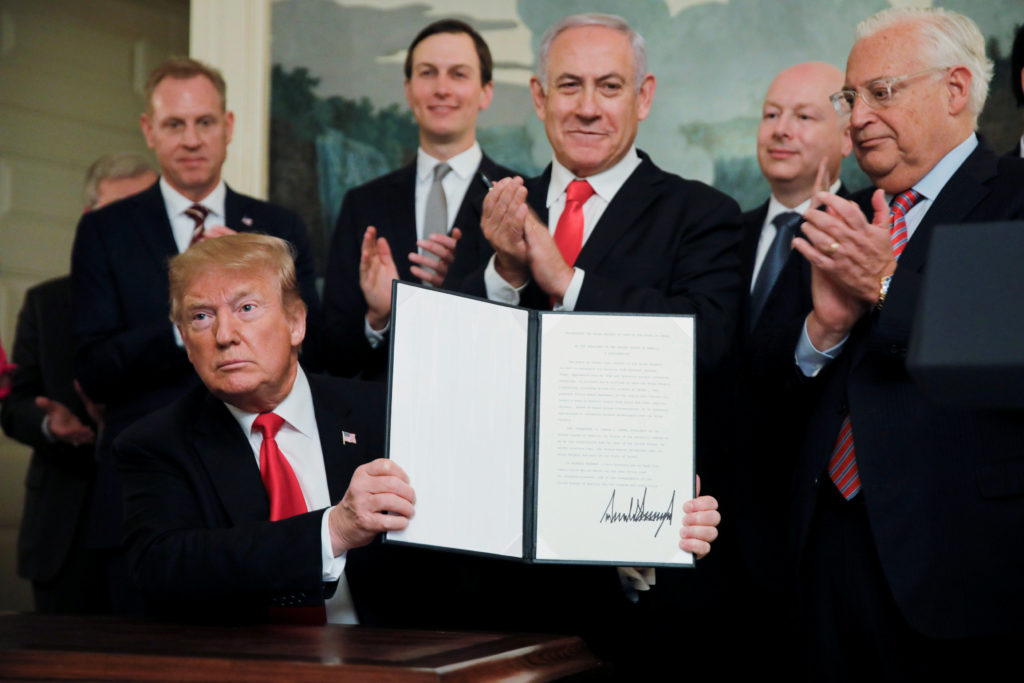
Donald Trump and Benjamin Netanyahu during the signing of the decision to recognize Israel’s sovereignty over the Golan – March 2019 (Reuters)
Illegal political decision
International reactions have overall condemned the US decision to recognize Israel’s sovereignty over the occupied Golan. The most prominent reaction has been Human Rights Watch’s report. The organization said that Trump administration’s decision to deny Israeli’s occupation of the Golan Heights expresses a disregard for the protection the Syrian people enjoy under international humanitarian law.
Eric Goldstein, Deputy Director of Human Rights Watch’s Middle East and North Africa Division said that “Trump seems to want to ‘drive a wrecking ball’ through international law that protects the people who live in ‘occupied Golan Heights’.” He added that “if this continues, it could embolden other occupying states to double down on their own land grabs, settlements and plunder of resources.”
Enab Baladi interviewed Ibrahim Olabi, Director of the Syrian Legal Development Program (SLDP), to discuss the impact and dimensions of Trump’s decision on the domestic and international levels as a whole, especially amid the rejection of all the Arab and foreign countries, as well as the aforementioned Security Council resolutions.
As a first point, Olabi says that the United States is usually part of the Security Council or international resolutions, including the decision to reject Israel’s sovereignty over the Syrian Golan.
Olabi added that these decisions are what constitute international law, which is the output of the work of the countries. Thus, the US administration is trying to make the US decision to recognize Israel’s sovereignty on the Golan reach international forums, which may affect the international law in general on the issue of the occupied Golan.
The Syrian jurist considered that Trump’s recognition of Israel’s sovereignty over the Golan is like “putting out feelers” to know the positions of other countries, because the US needs international allies to amend the international law if that is its goal. Among these countries are the UK and the European Union countries, which in turn have stood against the decision and considered it illegal.
Since Trump’s ascension to the US presidency, he has issued several resolutions and has taken measures that have overall violated the international law. Not only that, but these measures have also formed a violation of all the constants of US policy. Among these measures is the recognition of Jerusalem as the capital of Israel, which is a clear violation of more than 16 resolutions issued by the Security Council, most notably Security Council resolutions 476 and 478 of 1980.
By taking a closer look at Tramp’s policies after his ascension to the presidency, it can be clearly seen that he is preparing for a fundamental change in the form of the international order and trying to override all the stipulated rules in the international law.
As for the decision to recognize Israel’s sovereignty over the Golan, Olabi considers that this decision poses the biggest problem at the local level, in case it is locally made legal in the US. This decision has an economic dimension, as many companies cannot operate in the Golan, as it is an occupied area.
However, American companies that do not take the international law into account can find a pretext to work in this region (Golan), because the decision of recognition confirms Israel’s full sovereignty over the Golan, according to Olabi.
He considers that the steps the US president has taken are “dangerous.” It is clear that he is not fully interested in the international law, although he is part of it and part of the decision-making process. Olabi pointed out that “the US is causing international destabilization through the steps it has been taking, the most recent of which is the decision to recognize Israel’s sovereignty over the Golan.”
Olabi agrees with Bassam Tablieh, an international law and human rights expert who believes that Trump’s declaration is a political decision through which he offers part of Syrian territories to an occupying state flouting all Security Council’s resolutions.
During an interview with Enab Baladi, Tablieh describes Trump’s move as a violation of international law. Therefore, it cannot be taken into account for it allows a mighty state to take its right by force, and this conforms to the law of the jungle.
To what extent can this decision be enforceable?
Could Trump’s decision be repealed after the end of his term? During an interview, Enab Baladi addressed this question to legal expert Ibrahim Olabi, who explained that the decision could be rescinded after the end of Trump’s term. Olabi referred to Obama’s decisions previously revoked by Trump after his rise to power and the legislative decrees he issued.
Trump signed an executive order to withdraw from the Trans-Pacific Partnership (TPP) Agreement, which was the center focus of President Barack Obama’s policy, in addition to the comprehensive agreement on the nuclear program of Iran, which has been concluded through strenuous negotiations that ended in May 2015.
Therefore, the US president’s decision is a presidential declaration rather than a law passed by the US Congress. Any of Trump’s successors will be capable of revoking this decision completely.
This can be compared to the Paraguayan government’s decision as regards to Jerusalem. Three and a half months after the inauguration of the country’s embassy in Jerusalem by former Paraguayan President Horacio Cartes, his Lebanese-born successor, Mario Abdo Benitez, revoked this move and announced the return of the embassy to Tel Aviv. Benitez was elected president at that time (May 21, 2018) and he was opposed to the process of moving the embassy.
Golan Heights Wealth enticing Israel
“Agriculture is a source of income that should not be discarded,” said Israeli Prime Minister Benjamin Netanyahu during his visit to the Golan Heights on October 8, 2018. This may reflect the extent to which the Golan Heights, which are characterized by fertile soil and strategic water reservoir, are important to Israel.
“Developing and promoting tourism in the Golan Heights contribute to attracting tourists from Israel and abroad, strengthening and developing health services in the Golan Heights and offering plans and investment,” clarified Netanyahu, adding that “the Golan will flourish and succeed.”
The Golan Heights represent strategic assets for Israel. Over the past few years, the Israeli government has worked to expand agriculture fields in the Golan and provide facilities to settlers there. In 2014, the Israeli cabinet approved a proposal to develop 30,000 dunums of agricultural land in the area for agricultural exploitation. The plan meant to establish 750 agricultural cities, an investment worth 108 million dollars.
The Golan Heights cover an area of 1,160 million square kilometers and the lands used are divided as follows:
- Around 470,000 dunams are pastorals, for settlers own about 15,000 cow and 5,000 sheep
- 100,000 dunams of land for natural reserves
- Another 100, 000 is dedicated for the Israeli army
- 84,500 are agricultural lands given to settlers
According to the study entitled “Golan Heights and Water: A Study of the Relationship between Occupation and Water Resources” and issued in 2009.
The Golan Heights are famous for cultivating different crops. According to a study issued in 2014 by “Who Profits,” an independent research center, the Golan Heights’ exports consist mainly of grapes, apples, melons, citrus, tomatoes, corn, onions, olives, beans, parsley, garlic, pepper and herbs. Besides, the Golan Heights cover Israel’s need for Kiwi.
The revenue brought by the Golan agricultural products provides Israel with around 143 million dollars and cover the needs of Israeli market as follows:
40% of beef, 30% of apples, 32% of potatoes, 23% of corn, 50% of cherries, 41% of wool, 28% of eggs and 6% of milk.
Over the past few years, Israel developed a tendency toward cultivating grapes in the Golan for manufacturing and exporting wine. Tel Aviv exports wine worth 22 million dollars annually, 38 % of which is secured thanks to the Golan Heights.
The Golan Heights have a wonderful climate and landscape that attract tourists, along with medical tourism, thanks to mineral baths called “Hamat Gader.” Tel Aviv had also implemented projects of solar power plants in the region.
In addition, the Golan Heights water caught a great deal of Israel attention as well as its officials, for the Golan Heights are characterized by heavy rains. The Golan Heights contain 12 underground water tanks that collect rainwater, according to the Israeli newspaper Haaretz. Lake Tiberias represents the first source of freshwater for Tel Aviv, and secures one-third of the Israeli water supply.
In November 2015, The Economist published an article entitled “Black Gold under the Golan,” in which it tackled exploration activities carried out by Israeli and US companies in the region. Yuval Bartov, the Chief Geologist at the US Company Genie Oil, declared that his company believes it had found an oil reserve, which is “likely to provide billions of barrels.”
The Golan Heights bear an important security function for it provides Israel with an excellent site to monitor the Syrian movements, and protects it against any military attack from Syria thanks to their topographical characteristics.
“Giving up this land will be a strategic nightmare for Israel,” for “it provides a strategic platform to monitor southern Syria, Damascus and beyond,” said US Senator Lindsey Graham in a statement.
The Golan Heights provide Israel with observation points providing an in-depth surveillance in Syria thanks to the watchtowers Tel Aviv has established in the Golan, according to the Conversation website.

Israeli soldiers on a sled in Mount Hermon in the Israeli-occupied Golan Heights near Israel – January 2019 (Reuters)
Despite the fact that entire villages have been displaced from the Golan, the ties of a unified homeland continue to bring together many Syrians, regardless of nationality or religious differences characterizing the Syrian society. However, the situation has changed with the first generation’s grandchildren, who know nothing about their occupied lands other than mere stories and narratives.
The beginning was in 1967, when thousands of displaced people headed from the region towards various Syrian provinces. Thus, most of these people settled down in Damascus and its countryside.
Five villages remained populated in the Golan, namely Majdal Shams, with the largest demographic proportion, Buqata, Mas’ade, and Ein Qiniyye as well as Ghajar.
Four of the remaining villages belong to the Druze, while the inhabitants of the fifth village belong to the gypsies, along with only two Christian families.
Before the occupation, several nationalities lived in the Golan, including Circassians, Arabs and Turkmen. However, most of them emigrated during the war, especially those living in the center of Quneitra, which was inhabited by a Muslim majority that immigrated to the inside of Syria.
Most of the young people, who are the descendants of the displaced Golan locals, do not know their villages and towns. This is what Mohamed, a university student from the Golan Heights, told Enab Baladi, indicating that his father immigrated in 1967 from the Golan when he was young and settled down in Damascus.
Mohamed, 25, who originally belongs to the occupied part of the Golan, refused to describe his people as “displaced” and preferred to call them Golan locals.
As far as communication between the displaced Golan locals is concerned, Mohamed stated that they used to communicate through speakers, but today, means of communication varied and became simpler thanks to social media platforms.
Like dozens of young people, Mohamed has never been in his hometown. However, he feels nostalgic and draws memories of his country, which he did not see, through visiting a website named Jawlany.
Rifat Amasha, one of the locals of the Golan who is still living in the occupied part of the region, told Enab Baladi that most relations established by the locals and the displaced persons are maintained through social media platforms or meetings in Jordan, pointing out that this subject is “vast and complex.”
He added that since the occupation of the Golan Heights until today, generations were born under this situation. However, the standing social relations between the displaced persons and the locals within the occupied territories are a “replica” of other social ties maintained between all different social groups inside Syria.
Contacts between residents inside and outside the occupied territories continued through clerics entering the country and students studying at the University of Damascus. These methods have preserved mutual communication between both sides and renewed old relationships.
Amasha indicated that the social composition of the Golan reflects the Syrian society and mirrors a similar image of social relations within the Syrian border, such as those caused by the war and the differences that the regime sought to ingrain in Syria. He noted that the same type of social tensions are present in the Golan, but vary in intensity from village to village and town to town.
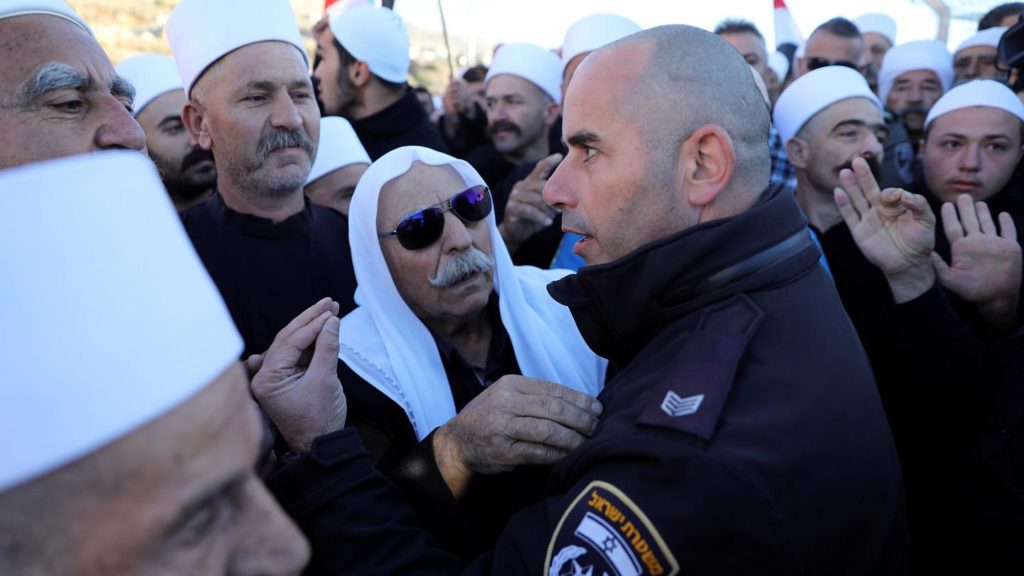
Protesters in the Golan angry about a demonstration against the elections outside the municipal polling station in Majdal Shams – 2018 (Reuters)
Continuous efforts to grant the Golan population Israeli nationality
While superficially adopting a “democracy based on freedom of choice,” Israel is constantly attempting to open the file of granting the Syrians of the occupied Golan the Israeli nationality, which is a file that has been repeatedly rejected locally and in the UN Security Council.
Israel tried to exploit the political, social and economic circumstances and the changes taking place in Syria to try to convince Syrians that becoming an Israeli citizen is better than remaining under a government that “begs for national sovereignty.” Thus, the Israeli Ministry of Interior decided to hold local elections in the occupied Golan villages last year.
The Israeli exploitation of the current situation has collided, as usual, with the locals’ unwillingness to accept Israeli citizenship.
Amasha asserted that the issue of the Israeli nationality is not new; it is rather a constantly renewed file. The population of the Golan today is estimated at about 25,000, “but only a small percentage of the locals hold the Israeli nationality,” He clarified.
Amasha added that Trump’s decision was not surprising. It has been announced informally since the 1980s, pointing out that the decision does not affect the public position of the people of the Golan.
The region witnessed its first strike in 1982, when the population of the Golan went on strike because of the issue of the Israeli citizenship. The strike was considered the longest of its kind, which in turn led to the imprisonment of about a quarter of the youth in the area, according to Amasha.
The public opinion in the occupied Golan issued an announcement entitled: “A Statement from the People of the Golan,” restricting all sorts of relations with the persons who took the Israeli nationality. No one is allowed to attend the joyous or sad events held by those who chose to become Israeli citizens. No one is supposed to share religious, social and political affinities with the aforementioned individuals, and no prayers are to be held when they die. Moreover, the holders of the Israeli citizenship are banned from mingling with the population, according to Amasha, who also referred to the recent complacency regarding the issue. However, the popular rage against the ones who have been newly granted Israeli citizenships began to escalate again.
The rates of holders of Israeli nationality increased proportionately due to the increase in the number of heirs and mixed marriages with the Galilee and Mount Carmel areas, in addition to the tendency among some residents of the aforementioned areas to live inside the Golan.
Amasha stressed that 513 persons chose to become Israeli citizens in the town of Buqata, while in Majdal Shams there were more than 900, and the same statistics are to be found in the rest of the Golan villages. However, the largest number of Israeli citizenship holders is recorded among the families who emigrated from the occupied Palestinian territories in 1948.
According to Amasha, the residents of the Golan consider the application for Israeli citizenship “a disgrace” worthy of “blame” and punishment.
Tightened security measures after occupation: A change in control
After controlling the Golan and the deployment of the UN forces on the border between Syria and Israel, the Syrian regime sought to tighten the security regulations imposed on those who attempt to enter or leave the borders of the “liberated” area, which has been evacuated from the Israeli forces. Thus, the regime forces have imposed a security clearance on those wishing to enter the region, whether they were locals or outsiders.
In recent years, and since 2011, the region has witnessed a shift of dominance over the territory near the Golan border, as the area became no longer under al-Assad’s control and has been taken over by the opposition. Later on, the Syrian regime came back to the area as agreed upon under the settlement accord with the opposition mediated by Russia and Israel.
Mahmoud al-Mohamed, a resident of Quneitra province, told Enab Baladi that following the displacement of the locals, many among them tried to return to the lands that Israel did not occupy. However, they faced security scrutiny imposed by the Syrian regime for fear of carrying out attacks against Israel in the occupied territories. Al-Mohamed revealed that many young men from the town of Sayyidah Zaynab were arrested, as the authorities have had doubts about their intention to commit offences in the occupied Syrian territories.
Al-Mohamed, who was displaced from Quneitra province when he was young, said that al-Assad forces arrested a shepherd because Israel detained him after he approached the border fence, and he remained in custody for nine months.
Al-Assad forces imposed on Syrians who are not citizens of Quneitra a security clearance to enter the area; however, they cancelled the decision after identifying their personal papers through the use of registered national credentials, according to al-Mohamed.
Mohammed, a university student from the occupied territories in the Golan Heights said that before the Syrian war, the Golan people did not face obstacles to enter to and exit from the area, and that a number of young people were studying at the University of Damascus. But with the beginning of the conflict in Syria, the situation changed and the road leading to the Golan has become unsafe.
At the end of 2011, there was an agreement between the branch of Saasa and the residents of the area about the dissident militants of its citizens. It stated that they should remain in the town of Jubata al-Khashab, which is forbidden to al-Assad forces under the 1974 agreement, provided that they do not carry out military operations inside the territories under the regime control.
On February 28, 2012, al-Assad forces stormed the village of Jubata to arrest dissidents in the area, which led to clashes between the Free Army and al-Assad forces, killing five civilians, four dissidents and militants of the regime, a news source from the province of Quneitra told Enab Baladi.
The source, who asked not to be named for security reasons, said that the raids were the spark of the spread of the Free Army in the region publicly and the fighters’ launch of operations against al-Assad forces there, contrary to what was previously agreed upon between the branch of Saasa military security and residents of the town of Jubata al-Khashab.
The Syrian regime and its forces did not launch any military operations towards the region until the summer of 2018. It controlled most of the areas close to Quneitra and its areas without fighting, after two separate agreements signed with the opposition factions.
The first agreement was signed after the collapse of Daraa, following battles in Quneitra. Negotiations were conducted in two separate ways. The first was between the Syrian regime and the factions of the Southern Front under Israeli auspices. It stipulated maintaining the fighting factions of the Front and the establishment of something similar to self-management in the region.
In the meantime, the second part of the negotiations was taking place between the Islamic factions represented by Al Furqan Brigade, Al-Nusra Front and Ahrar al Sham on the one hand, and Russia on the other. The factions withdrew to the north under the agreement, according to the same source.
Following the departure of the factions from the region, the Lebanese Hezbollah began to include a number of fighters who fought directly and remained in the region as “sleeper cells,” according to the source. He pointed out that the area near the fence with Israel is indirectly but fully under the control of Hezbollah.
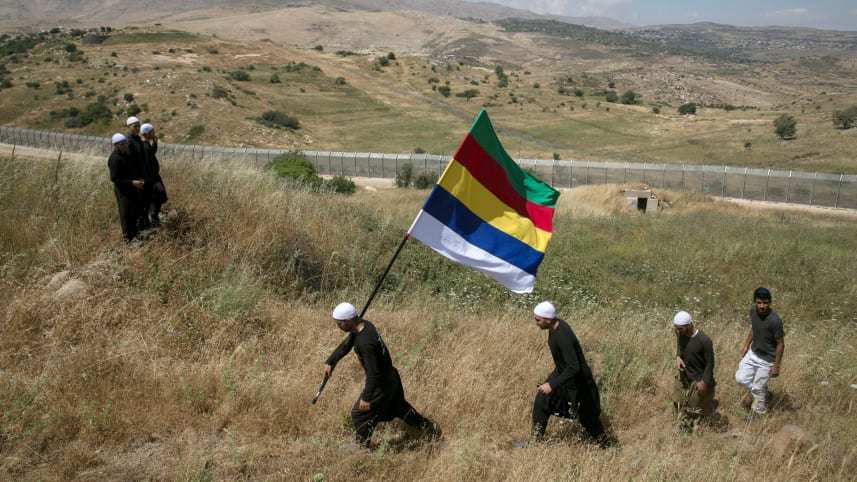
Militants of the united Druze community in the Golan Heights walking near the border fence with Syria – February 2018 (Reuters)
Demographics of the Golan
The history of the Golan dates back to the beginning of the formation of the civilizations in Syria, as the fertility of its land has made it a desirable location since ancient times. Its history, which has been full of conflicts throughout the ages, has now led to the conflict between Israel and its Syrian citizens.
While the Israelis claim in their archives their right to the land of the Golan, citing the Bible and Old Testament texts, the CIA said in its report on the region on December 31, 1981, that “the Golan Heights were never part of the Jewish State” for more than 3,000 years.
The Golan’s original inhabitants are Arabs belonging to immigrant tribes from Yemen, such as the tribe of Ghassan and al-Azd, who came from the Arabian Peninsula centuries before Islam, according to researcher Asmaa Shahwan in a study entitled “Zionist Settlement in the Syrian Golan Heights.”
Arabs constituted 85% of the population in 1966, in addition to Circassians and Turkmen. Most of them followed Islam and Sunna, but the region included minorities from the Druze, Alawites and Christians.
Estimates of the exact population of the region varied from 130 to more than 140,000, and included some 13,000 Palestinian refugees.
Most of them left after the 1967 war, and Israel expelled most of those remaining and cleared most of the Syrian villages, according to the US intelligence agency.
Only six villages remained, which are Majdal Shams, Bakaata, Ein Qiniyye, Masade and Shayta, which include residents of the Druze community, and the village of Ghajar, which includes Alawite residents and according to a 1967 census its population was 6,400.
Today there are 33 Israeli settlements of 20,000 Jews, with some 20,000 Syrians in the Golan Heights. The mayor of one of the settlements announced plans to increase the number of Jewish settlers in the region following the American recognition of Israeli sovereignty. Dimi Abartsev told Sputnik on March 26, 2019, that Israel intends to raise the Jewish population in the next 10-15 years to 150,000 to become a majority.
Historic events
if you think the article contain wrong information or you have additional details Send Correction
النسخة العربية من المقال
-
Follow us :












 Syrian citizens in Golan (AFP)
Syrian citizens in Golan (AFP)





 A
A
A
A
A
A

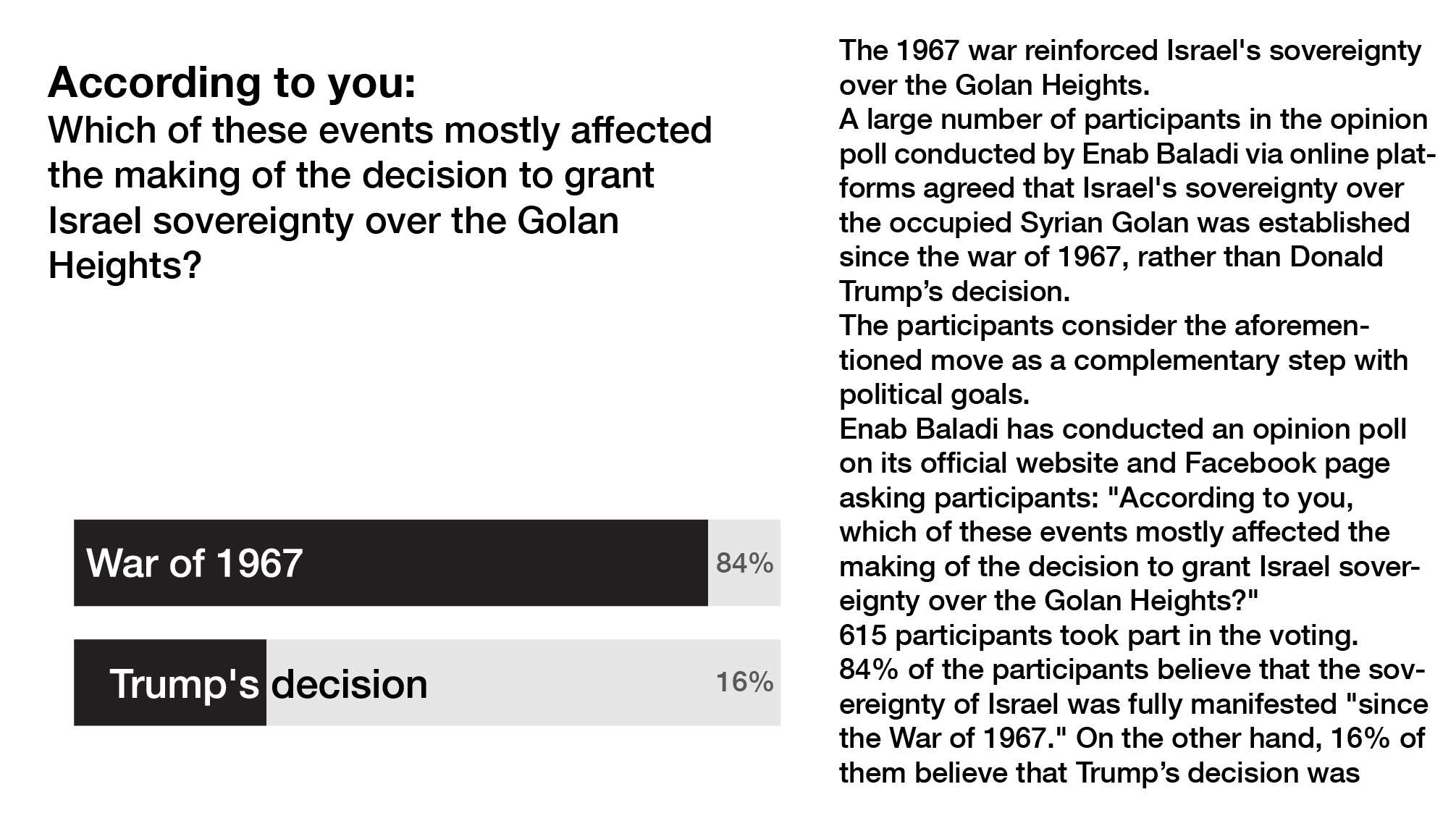
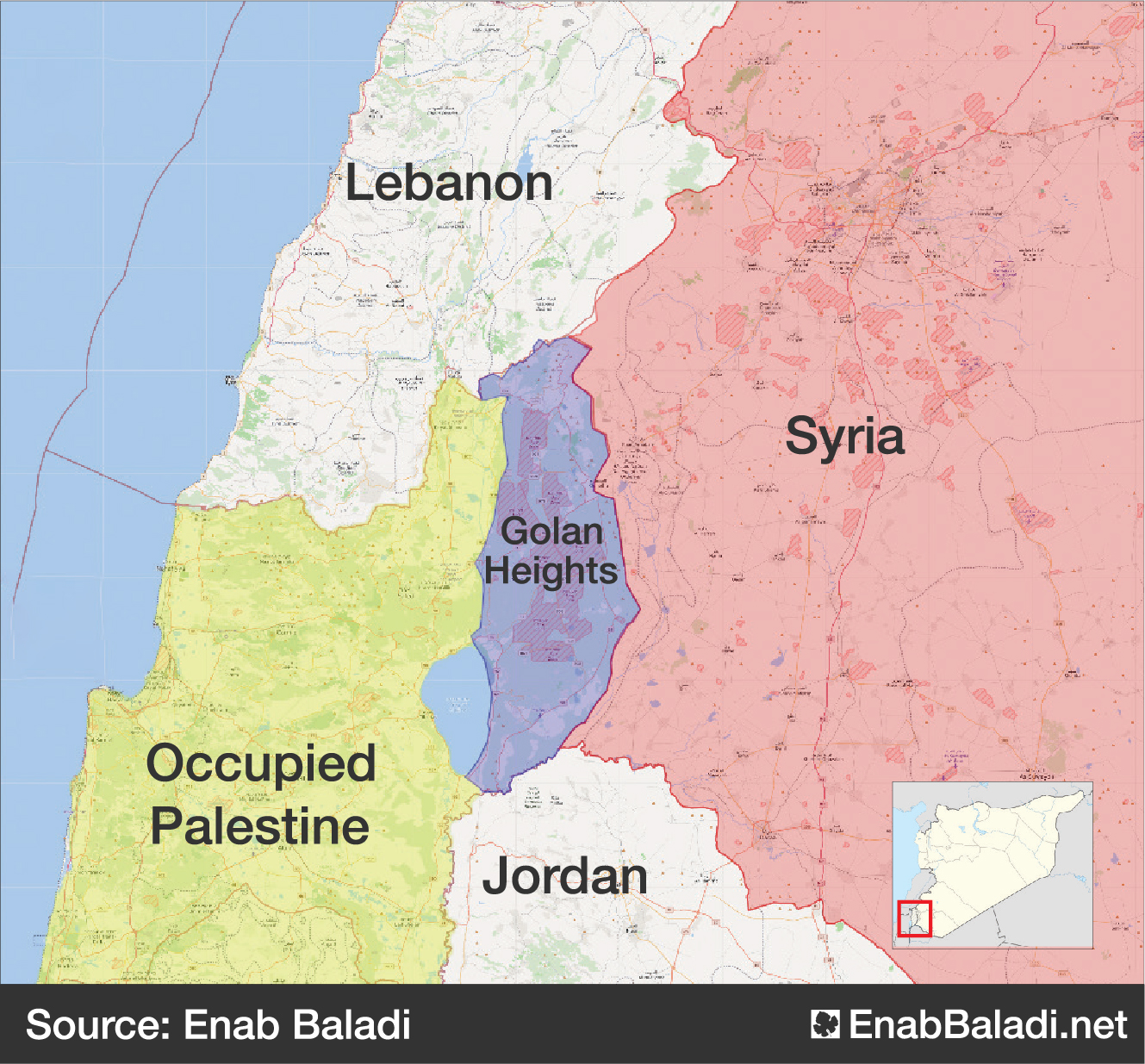



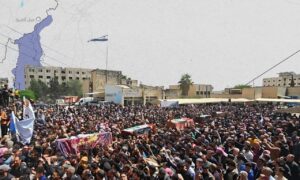



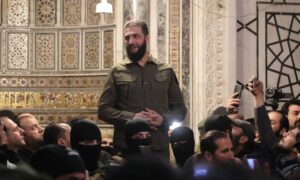
 More In-Depth
More In-Depth